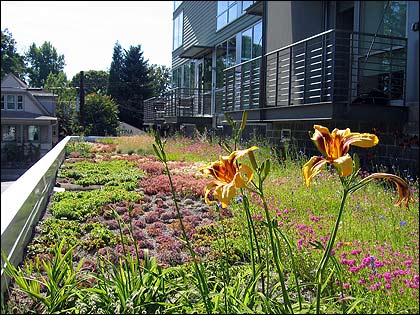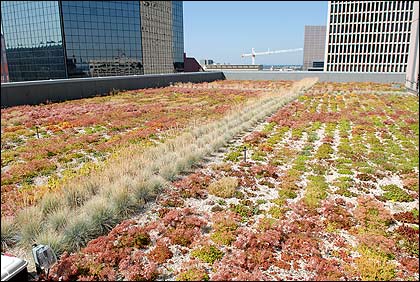Digs: EW’s guide to green homes & gardens
Farms Not Lawns Defense against divisions in your own back 40
Low VOCs for My Undies Refinishing furniture the low-toxic way
Green Digs LCC offers low-carbon, car free living downtown
Green on Top Great for the environment, wallet, health and wellbeing
Where To Find Used Home & Garden Materials
Green on Top
Great for the environment, wallet, health and wellbeing
By Heather Cyrus
Aøgreen roof” in Eugene doesnt mean that theres moss covering your house. Installing an actual green roof can increase urban green space and reduce negative impacts on air and water.û
 |
| Hawthorne Condos in Portland (design by Jason King / Ecoroofs Everywhere). Photo by Greg Haines |
 |
| Portland Building in Portland (design by Jason King / Macdonald Environmental Planning). Photo by Jason King. |
A green roof, or ecoroof, is a living system that replaces a conventional roof and can be incorporated into new buildings or retrofitted on existing ones. An ecoroof is a thin layer of vegetation growing in substrate of engineered soil on top of a waterproof membrane. In other words, you have plants growing on top of your house. Moss is not a green roof; its just wet and messy.
According to Roxi Thoren, assistant professor in the departments of Architecture and Landscape Architecture at UO, green roofs provide environmental benefits including filtering air pollutants, absorbing carbon dioxide, providing habitat for pollinators, reducing the øheat island effect” in which built-up areas get hotter than rural areas, and decreasing stormwater runoff.û
Ecoroofs provide economic incentives as well. øThere is some debate over the economic benefits, although it is generally accepted that a home or building will stay cooler in the summer with a green roof,” Thoren said. This translates to lower cooling costs.û
According to Thoren, the lifespan of a conventional roof ranges anywhere from 15 to 40 years, depending on climate and materials. A green roof may last 50 to100 years. øWhat usually breaks down a conventional roof is exposure to vast temperature changes,” Thoren said. Temperatures can change more than 60 degrees in one day on a roof, and the constant freezing and thawing creates an øexpand and contract” motion that causes wear and tear. The green roof provides a layer of protection from this process.
Finally, the aesthetic appeal alone convinces many to believe in the power of green roofs. øA living roof can raise property value in the same way that living by a park can,” said Thoren, who designed her current home with a green roof. Additionally, ecoroofs can be noise insulators to help drown out loud neighbors or traffic.
Thoren explains that green roofs are not composed of typical garden dirt; rather, they are made of engineered soil containing 75 percent pumice, 15 percent compost (organic material) and 10 percent sand.
øIts important to understand that a roof is a nonnative environment,” Thoren said. øSome native species, such as camas, do great because they are dormant in the hot season, but the best plants for green roofs are typically nonnative.” However, Rich Hindle, a visiting instructor for the Department of Landscape Architecture at the UO, is testing the feasibility of native species in this area.û
Hindle taught a living building course last summer where students designed and planted an ecoroof test site on a shipping container in the vacant lot next to the new U.S. courthouse in Eugene. The students planted 100-percent Oregon native plants at the site.
øIts hard to tell right now how well the plants are doing because its winter, but the students will be returning to the site in the spring to make observations,” Hindle said.û
Hindle and Thoren agree that succulent and sedum plants perform well on green roofs. Succulents retain water and are adapted to arid climates and soils. Sedums are stonecrops, species of succulents that grow well in rocky substrate. Only two sedum species were planted at the test site.
Hindle is interested in testing and promoting regional green roofs. øThe Eugene area is ripe with individuals who care about buying local,” he said. øI would like to build green roofs with local materials and plant local species.”
The first two years of the ecoroofs life, the establishment period, is crucial for long-term success. There is some debate about the level of maintenance necessary after the establishment period, ranging from consistent watering to none at all, and Hindle says that weeding is optional.û
There are financial incentives the city of Eugene may provide by way of reduced system development charges for storm water. For more information on these incentives visit www.eugene-or.gov/greenbuilding
Thoren and Hindle recommend consulting with an engineer and landscape architect prior to any green roof installment.
March is ecoroof month in Portland, and the Portland Bureau of Environmental Services is offering free tours of some of the 271 (covering 12.75 acres) ecoroofs in and around the city. Visit www.portlandonline.com for more information and register for tours; and to see one of Eugenes green roofs in action, head over to SeQuential Biofuels, off the 30th Avenue exit. û û û û û û û